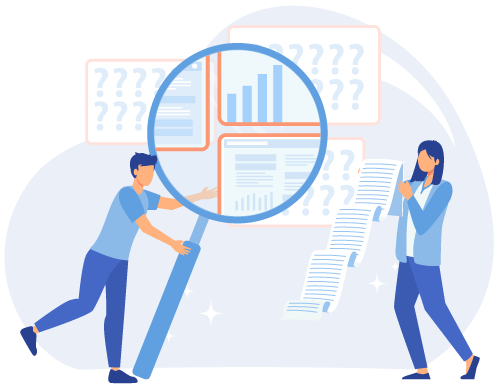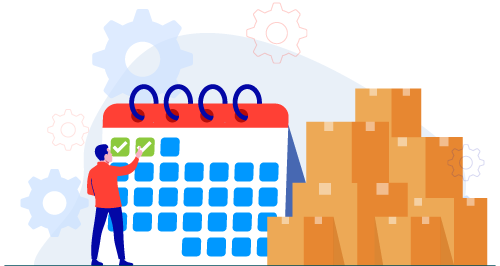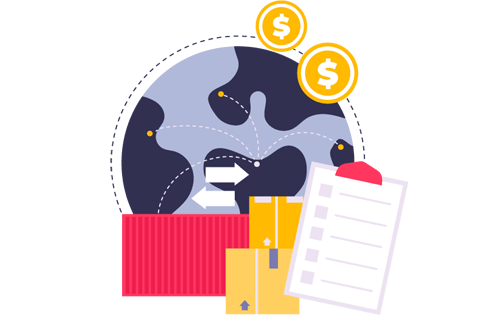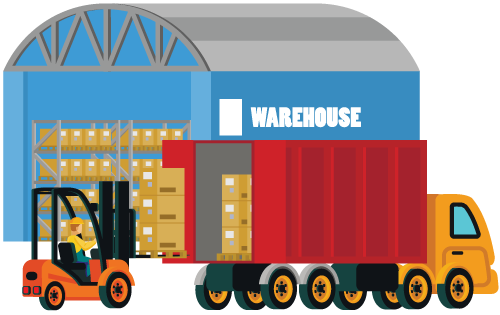What is Forecasting Analysis?
Built For


- Different types of forecasting analysis
- Benefits of forecasting analysis
- A simplified breakdown of the concept
- Technological advances that simplify forecasting
What is Forecasting Analysis?
Have you ever found yourself overstocked with products that just won’t sell or, on the flip side, totally underprepared for a customer rush? That’s where forecasting analysis swoops in to save the day, especially when paired with inventory management software.
Forecasting analysis isn’t just a fancy term that data analysts throw around; it’s the tool every small to mid-sized business should use to predict and plan for the future. When it comes to inventory management, it’s all about striking that perfect balance between too much and not enough. And guess what? You don’t need to be a prophet or a math whiz to get it right.
Today, we’re diving into how forecasting analysis and inventory management software can turn your inventory nightmares into a well-organized dream. We’ll explore how this dynamic duo can help reduce costs, keep your customers happy, and make those stock levels’ just right’. So, let’s unravel the mystery of forecasting analysis in inventory management!
Types of Forecasting Analysis
Forecasting analysis can seem like a maze of numbers and charts, but it really boils down to a few key types you can use to ensure you’re not caught off-guard with your inventory.
Qualitative Forecasting
Have you ever asked a buddy for their gut feeling on something? That’s qualitative forecasting in a nutshell. It’s less about crunching numbers and more about using human intuition, opinions, and subjective information to predict future demand. Here’s how it works in the biz world:
- Market Research: This is like taking the pulse of your market to see what’s trending. It involves gathering customer feedback, conducting surveys, and keeping an ear to the ground through social media.
- Sales Force Estimates: Your sales team is on the front lines, and their insights are gold. Based on their interactions with customers, they can predict future market trends.
- Expert Panels: Sometimes, you bring in the big guns – a group of industry experts who can forecast what will fly off the shelves based on their experience.
Quantitative Forecasting
Now we’re talking numbers. This is all about using historical data to predict future events. It’s a bit more complex but helpful in spotting patterns you can bet on.
- Time Series Analysis: Consider this the rhythm of your sales – it looks at past sales data over a specific period to identify trends.
- Causal Models: If you’ve ever said, “If A happens, then B will likely follow,” you’ve thought in causal models. This method considers factors like market trends, economic indicators, or even the weather that could affect demand.
- Moving Averages: This method smooths out those pesky sales peaks and valleys to give you a clearer picture of the trend over time.
- Exponential Smoothing: Sounds fancy, right? It’s a way to give more weight to recent data, which can be handy if your market changes quickly.
Each method has its use, and the key is determining which one aligns with your business vibes and inventory needs. By getting a handle on each forecasting type, you can turn the art of inventory management into a science that works for you.
Benefits of Forecasting Analysis for Inventory Management
So, you’re probably wondering, “What’s in it for me?” regarding forecasting analysis. Integrating forecasting into your inventory management isn’t just about looking smart—it’s about making decisions that save time, money, and stress. Here are the game-changing benefits:

Say Goodbye to Overstocking
Have you ever felt the pain of a product collecting dust on your shelves? With forecasting, you can wave goodbye to the days of overbuying and slow-moving inventory. By predicting the right amount of stock you’ll need, you’re putting your money where the sales are.
Avoid the Dreaded Stockout
There’s nothing quite like the face of a disappointed customer (even virtually) when you don’t have what they need. Forecasting helps you keep enough inventory on hand to meet demand—no more or less. It’s all about being prepared for that unexpected rush without going overboard.
Keep Your Cash Flow Happy
Cash is king, and inventory ties up a lot of it. By getting forecasting right, you’re not just managing products; you’re managing your money. Intelligent forecasting means better cash flow management, letting you invest in new opportunities instead of excess stock.
Stay Ahead of the Curve
Markets change, trends come and go, and demand shifts. Forecasting keeps you one step ahead, so you’re always riding the wave of what’s current rather than playing catch up.
Customer Satisfaction Through the Roof
When you have what customers want, when they want it, they’re happy campers. Happy customers come back, and they tell their friends. Forecasting analysis helps ensure you can always provide your customers with precisely what they’re after.
Streamlined Operations
When you know what’s coming, you can plan better. That means scheduling staff, organizing storage space, and managing shipping and receiving like a well-oiled machine. It’s the kind of efficiency that can turn a good business into a great one.
Sustainability and Responsibility
No one wants to see products go to waste in today’s world. Forecasting helps you order more responsibly, reducing waste and ensuring that you’re a business thinking about the planet and profits.
Forecasting analysis is about making informed choices that benefit your customers, bank account, and even the Earth. Get it right, and you’ll wonder how you managed inventory without it.
Steps in Forecasting Analysis
Diving into forecasting can seem like prepping for a space mission, but breaking it down into steps simplifies the concept.

Define Your Goals
Before we start crunching numbers, let’s figure out what you’re aiming for. Want to reduce backorders? Increase turnover rates? Understanding your endgame will shape your forecasting strategy.
Gather Your Data
Data is your rocket fuel. Sales history, market trends, promotional calendars—you’ll need all of it. Your inventory management software can be a goldmine of info, so start digging!
Cleanse and Organize Your Data
Messy data leads to messy forecasts. Organize your data chronologically, remove any anomalies, and ensure it’s as accurate as a Swiss watch. This step is crucial for a precise analysis.
Choose Your Forecasting Model
Remember the forecasting types we discussed? It’s time to pick your dance partner. Whether you use qualitative, time series, or causal models, select the one that resonates with your business rhythm.
Run the Numbers
It’s showtime! Crunch the data using your chosen model. This could mean calculating moving averages or delving into more complex statistical methods. Your inventory software might have tools to help with this, so leverage them!
Analyze the Results
What’s the data telling you? Look for patterns, trends, and insights to guide your inventory decisions. Are certain products consistent bestsellers? Is there a seasonal spike? These nuggets of wisdom are pure gold.
Apply Your Insights
With analysis in hand, start applying what you’ve learned. Adjust your stock levels, plan purchasing, and align your operations with the forecasted demand.
Review and Adjust Regularly
Data is your rocket fuel. Sales history, market trends, promotional calendars—you’ll need all of it. Your inventory management software can be a goldmine of info, so start digging!
Communicate with Your Team
Ensure everyone from sales to the warehouse understands the forecast and why it’s essential. A forecast is only as good as the team working with it.
How Inventory Management Software Simplifies Forecasting
Forecasting might sound like a monumental task, but inventory management software simplifies much of the process.

Automated Data Collection
Imagine having an assistant who tirelessly gathers all the data you need without you lifting a finger. That’s your inventory management software! It logs every sale, return, and stock movement, compiling a treasure trove of data ready for analysis.
Real-Time Visibility
With inventory management software, you can instantly see what’s happening in your stockroom. No more guessing games, just live updates that keep your forecasting on point and responsive to the latest trends.
Historical Sales Analysis
Want to see how you did last Black Friday or during the summer sale last year? Your software can pull up those figures in a snap, helping you predict how much stock you’ll need when those times roll around again.
Easy-to-Use Forecasting Tools
Inventory management systems have built-in forecasting tools that do the heavy lifting for you. Just select the data points, click a button, and voilà! You’ve got forecasts that can inform your next move.
Integration with Other Systems
The best part? Inventory management software plays nice with others and integrates with QuickBooks and popular eCommerce platforms and marketplaces, ensuring everyone’s singing from the same song sheet.
Customizable Reporting
You want reports your way, and with inventory management software, you can focus on the metrics that matter most to you and your team for more targeted forecasting.
Alerts and Notifications
Never miss a beat with automated reorder alerts that tell you when stock is low (or too high) so you can act swiftly to keep your inventory in check.
By leveraging inventory management software, you’re not just forecasting; you’re setting up an intelligent, responsive inventory system that adapts to the ebbs and flows of your business. It’s like giving your inventory a brain – one that’s always thinking a few steps ahead. So, let the software do the research, and you can focus on making the strategic decisions that’ll keep your customers happy and your business thriving.
Forecasting Analysis for Inventory Management FAQs
What is forecasting analysis?
Forecasting analysis uses past and current data to predict what products you’ll need, how much, and when. Forecasting analysis prepares you for demand before it hits, ensuring you have the right amount of stock at the right time.
Why is forecasting important for small to mid-sized businesses?
For businesses of all sizes, every dollar counts. Forecasting helps manage your cash flow by avoiding excess stock that ties up funds and ensuring you don’t miss out on sales due to stockouts. Forecasting analysis is about being lean and intelligent with your resources so you can grow and thrive.
Can inventory management software make forecasting easier?
Absolutely! Inventory management software automates data collection, provides real-time inventory levels, offers forecasting tools, and alerts you when it’s time to reorder.
Do I need to be a data expert to use forecasting in my business?
Modern inventory management software is designed with user-friendliness in mind and with easy-to-understand interfaces and built-in forecasting tools.
How often should I review and adjust my forecasts?
Forecasting isn’t a one-and-done task; it’s a dynamic process that requires regular check-ins. Ideally, you should review and adjust your forecasts whenever you get new significant data, or at least monthly, to keep up with market changes and seasonality.
Call us at 817-870-1311





